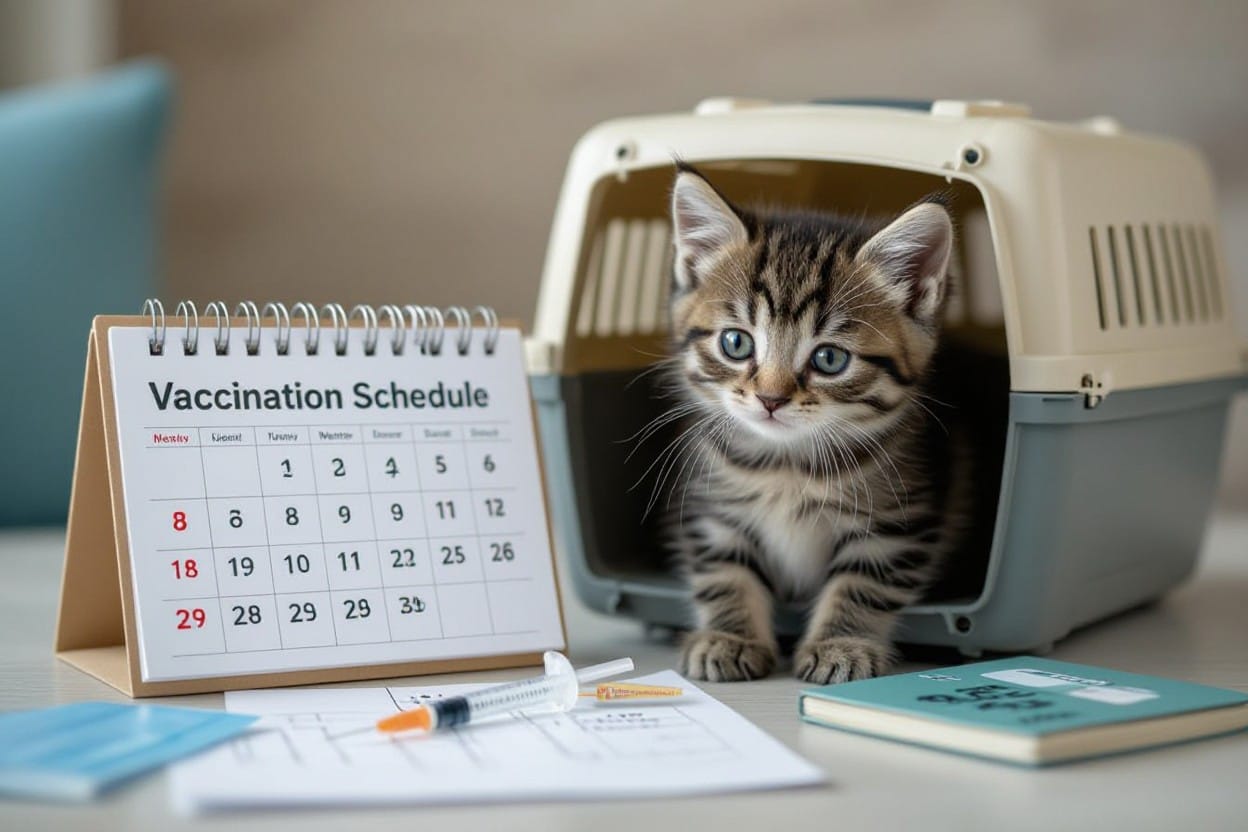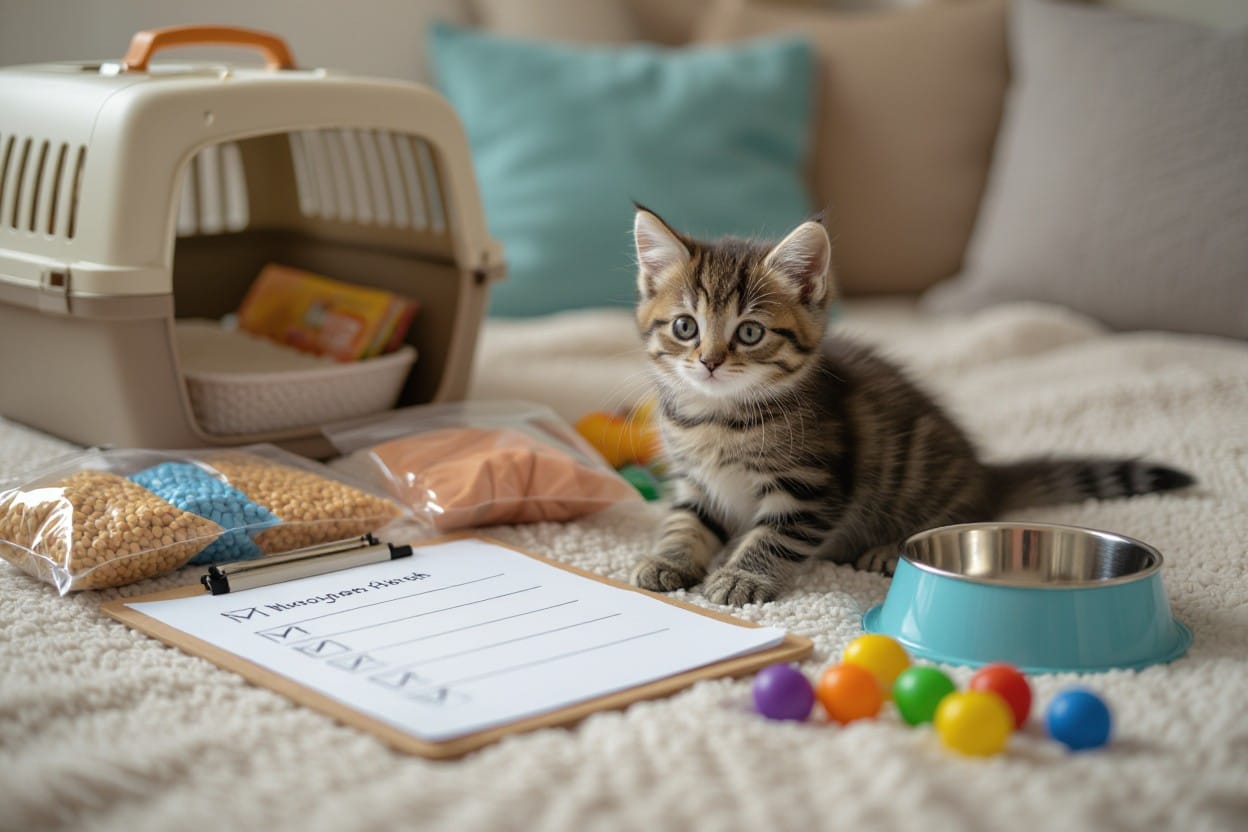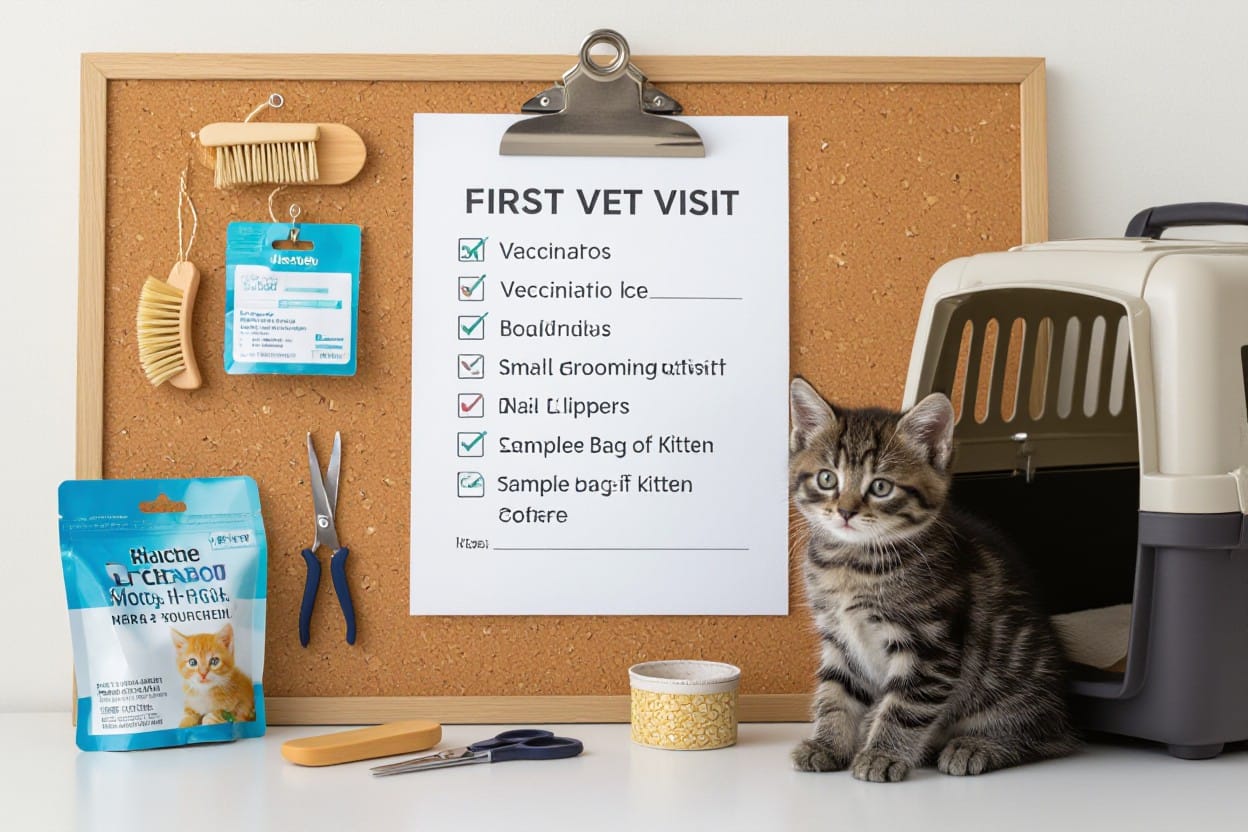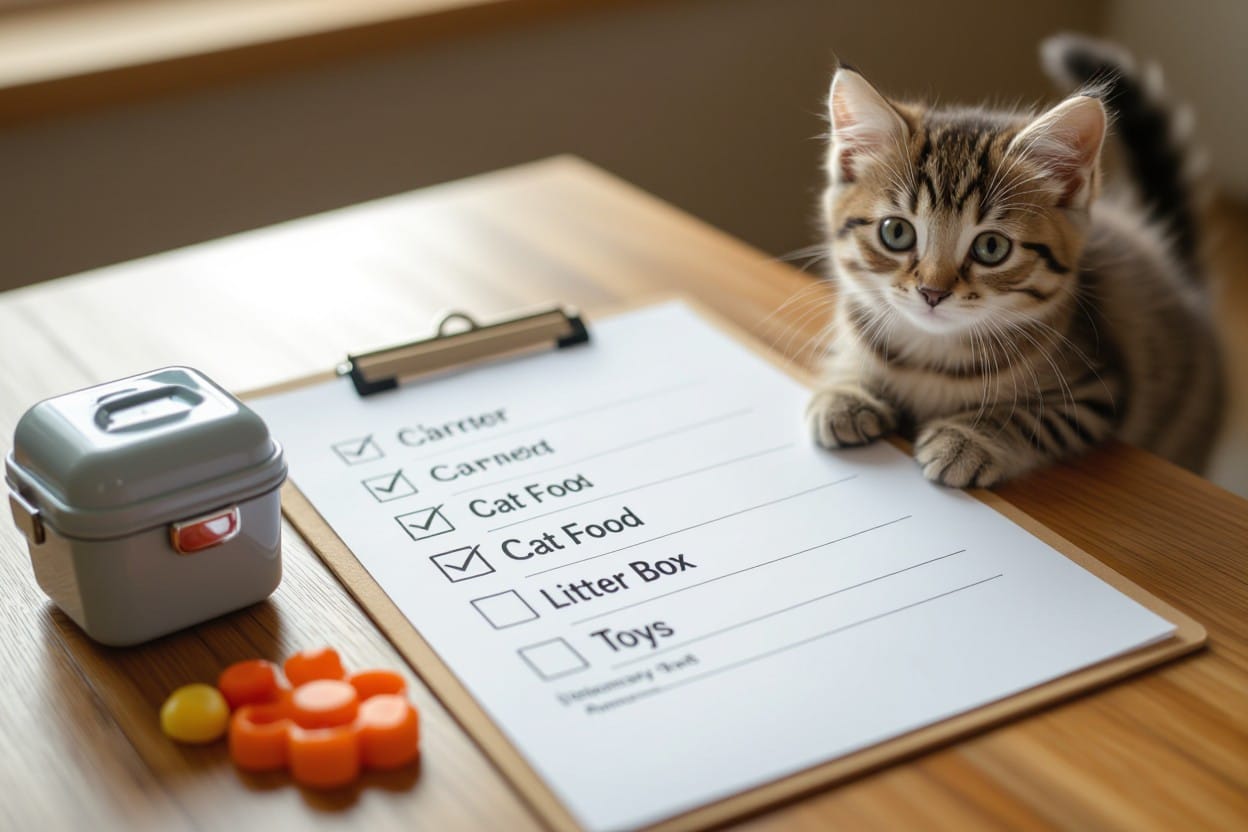There’s a clear first vet visit kitten checklist to guide you through what to bring, questions to ask your vet about your new kitten, and the steps of the new kitten vet exam; during the visit you’ll review the kitten vaccination schedule, get parasite and flea checks, and assess weight, temperature, and behavior. Watch for persistent vomiting, diarrhea, severe lethargy, or labored breathing, and establish a follow-up wellness plan and microchipping for your kitten’s long-term health.
Key Takeaways:
- Use a first vet visit kitten checklist: bring medical records, a stool sample, feeding schedule and a list of questions to ask vet about new kitten.
- Expect a new kitten vet exam: full physical, parasite screening and initiation of the kitten vaccination schedule (core vaccines and deworming timeline).
- Plan preventive care and follow-up: discuss microchipping/spay‑neuter timing, flea/tick prevention, nutrition and items on a kitten health exam checklist for future visits.
Importance of the First Vet Visit
Timing of the First Visit
Schedule your first appointment within 48–72 hours of bringing the kitten home, or immediately if the kitten shows signs of illness (lethargy, vomiting, diarrhea, labored breathing). If the kitten is under 8 weeks old, the vet visit should happen right away so you can start a tailored plan; the initial wellness check often leads to the first entry on your first vet visit kitten checklist.
After that initial visit, expect follow-ups every 3–4 weeks for vaccine boosters and growth checks until roughly 16 weeks of age. A typical cadence: weigh and exam at the first visit, then schedule the first FVRCP vaccine at 6–8 weeks with boosters every 3–4 weeks until 16–20 weeks; rabies is usually given at 12–16 weeks depending on local law. Note that kittens with fleas or signs of respiratory disease need faster intervention to avoid severe anemia or secondary infections.
Establishing a Health Baseline
The new kitten vet exam will cover a focused physical exam: weight and body condition score, temperature (normal feline range ~100.4–102.5°F), heart and lung auscultation, abdominal palpation, oral and ocular check, and limb/joint assessment. The vet will run a fecal test for intestinal parasites and may perform FeLV antigen and FIV antibody testing; these findings form the core of your kitten health exam checklist and guide early treatment decisions.
Vaccine and medical records, if any, get documented and paired with baseline photos and weight so you can track trends—losing or failing to gain >10–20 g/day in very young kittens triggers concern. Bring any adoption paperwork and be ready with a list of symptoms and prior treatments so you can ask targeted questions to ask vet about new kitten, such as expected weight gain, signs of dehydration, and dietary recommendations.
For kittens that appear unwell, the vet may add diagnostics: a CBC/chemistry panel to detect anemia or organ issues, an extended fecal PCR for protozoa, or radiographs if obstruction or congenital problems are suspected. A FeLV-positive or FIV-positive result changes housing and vaccination plans immediately and often prompts retesting and isolation guidance as part of the new kitten vet exam.
Preventive Health Focus
Vaccination planning is a major focus at the first visit: most vets start FVRCP at 6–8 weeks, then boost every 3–4 weeks until at least 16 weeks; rabies is typically given at 12–16 weeks per local regulations. Discuss FeLV vaccination based on lifestyle—outdoor or multi-cat households often receive FeLV vaccine starting around 8–12 weeks. Following a proper kitten vaccination schedule reduces risks of panleukopenia, calicivirus, and herpesvirus.
Parasite control and preventive meds get addressed as well: common shelter/small-clinic protocols deworm kittens at 2, 4, 6, and 8 weeks with agents like pyrantel or fenbendazole and repeat as recommended; topical flea products must be kitten-safe and matched to age/weight. Microchipping, spay/neuter timing (commonly 4–6 months), and tailored flea/tick prevention are added to the plan so your first vet visit kitten checklist covers both immediate and long-term prevention. Highlight any zoonotic parasites like roundworms so you understand risks to household members.
Vaccine and parasite choices are adjusted to your kitten’s lifestyle: indoor-only kittens may defer FeLV vaccine, while those boarding or going outdoors need broader protection. Ask specific questions to ask vet about new kitten—expected local disease risks, side effects of vaccines, safe over-the-counter products, and exact timing for the next booster—to turn the preventive plan into a clear, date-driven checklist. Following this plan delivers a reduced disease risk and clearer milestones on your kitten health exam checklist.
Pre-Visit Preparation
Information Gathering
Pull together your kitten’s basic history so the vet can work quickly through your first vet visit kitten checklist. Note age in weeks, exact adoption or rescue date, current weight, any treatments already given (dewormer, flea meds), and whether the kitten has been indoors only or had outdoor exposure. Have the microchip number, prior vet paperwork, and the brand and amount of food you’re feeding on hand; vets use those details during the new kitten vet exam to assess growth and nutritional needs.
Make a concise list of questions to ask vet about new kitten: the recommended kitten vaccination schedule (for example, FVRCP starting as early as 6–8 weeks with boosters every 3–4 weeks until ~16 weeks, and rabies typically at 12–16 weeks), timing for spay/neuter, parasite prevention, and any behavior concerns. Expect the clinic to run a fecal test, weight check, and a full physical as part of the kitten health exam checklist; flag any symptoms like lethargy, persistent vomiting, or bloody stools before arrival so staff can prioritize care.
What to Bring
Bring the paper and digital records: vaccine receipts, adoption or intake paperwork, current medication list, and the microchip information. Pack a fresh stool sample (within 24 hours) in a sealed, labeled container for fecal analysis, the exact brand of food the kitten eats to avoid diet transition issues, and any prescribed medications in their original bottles. Include a small blanket or towel with familiar scent, a favorite toy to reduce stress, photo ID, payment method, and your pet insurance information if applicable.
More info: collect the stool sample by placing a clean disposable tray or plastic bag in the litter pan and transferring feces into a clean container with a tight lid; store refrigerated if you can’t bring it right away. If the kitten shows signs of severe illness—difficulty breathing, continuous vomiting, or bloody diarrhea—call the clinic before traveling so they can prepare or advise immediate care.
Carrier Preparation
Choose a carrier that’s sturdy, has secure latches, and is large enough for the kitten to turn around but not so big that it slides during transport; hard-sided carriers are easier to clean and safer for vet visits. Line the carrier with an absorbent towel and a blanket with home scent, attach an ID tag or sticker with your contact info, and place the carrier in the car secured with a seatbelt to prevent shifting. Spray a synthetic feline pheromone (e.g., Feliway) lightly about 10–15 minutes before placing the kitten inside to reduce stress.
More info: start carrier acclimation at least 7–10 days before the appointment—leave the carrier door open in a common area, feed meals inside, and run short practice car rides so the kitten associates it with positive experiences. If your kitten is highly anxious, ask the clinic about pre-visit calming options and whether they recommend a short-acting medication or behavioral strategies for transport; noting this in your first vet visit kitten checklist can make the new kitten vet exam go much smoother.
Complete Physical Examination Process
Vital Signs Assessment
You’ll have the vet record temperature, heart rate, respiratory rate and weight as the first objective data on your first vet visit kitten checklist. Expect a rectal temperature in the range of 100.5–102.5°F (38–39.2°C), a kitten heart rate typically between 200–260 bpm, and a respiratory rate around 20–40 breaths/min; deviations from these ranges can signal infection, pain, or distress. Weight is compared to growth charts — for example, an 8-week-old kitten often weighs about 0.45–0.9 kg (1–2 lb) while a 12-week-old typically falls in the 0.7–1.1 kg (1.5–2.5 lb) range — and becomes the baseline for follow-up visits tied into the kitten vaccination schedule.
The vet will also check mucous membrane color, capillary refill time (normal <2 seconds), and skin turgor to assess hydration; pale gums, prolonged CRT, or tacky mucous membranes are signs that need prompt attention. Use the data from the new kitten vet exam to ask targeted questions to ask vet about new kitten, such as whether current vitals warrant delaying vaccinations or scheduling rechecks.
Systematic Physical Exam
Hands-on evaluation proceeds head-to-tail: eyes for discharge, corneal clarity and pupillary reflexes; ears with otoscope for dark debris (ear mites) or infection; mouth for ulcers, malocclusion, or retained baby teeth; lymph nodes, throat and trachea for enlargement or pain. Chest auscultation checks heart rhythm and murmurs (graded I–VI), while abdominal palpation assesses organ size, masses, or pain; palpation of limbs and joints can reveal dysplasia or fractures. Skin and coat inspection looks for fleas, flea dirt, ringworm patches, or dermatitis and the anal area is checked for hernias or impacted glands.
Specific findings guide next steps: an otoscopic exam showing copious dark cerumen with head shaking suggests otodectes (ear mites) and may trigger topical therapy, whereas a grade IV/VI murmur or irregular rhythm will prompt cardiac referral or echocardiography. Any signs of systemic illness—fever, marked lymphadenopathy, or a painful, rigid abdomen—may postpone nonurgent vaccines and alter the kitten health exam checklist plan.
More detail on palpation and diagnostics: gentle abdominal palpation differentiates a soft, non-tender gut from a tense, painful abdomen that could indicate obstruction or severe constipation; note that small intestinal foreign bodies often present with intermittent pain and vomiting, while diffuse pain plus lethargy raises the concern for septicemia or systemic infection. Otitis externa with dark crumbly material often responds to topical parasiticides, but purulent drainage and a ruptured tympanic membrane require systemic antibiotics and possibly culture.
Observational Insights
Watching behavior during the exam gives you and the vet clues beyond numbers: activity level, social response, gait, and how the kitten eats or snacks in the exam room. Persistent sneezing, bilateral mucopurulent ocular discharge, or conjunctivitis are common shelter-associated upper respiratory signs often caused by feline herpesvirus or calicivirus and can influence isolation and treatment decisions under the what to expect first vet visit portion of your first vet visit kitten checklist. Note any coughing or labored breathing—cyanotic or blue-tinged gums and open-mouth breathing are emergencies.
Report home observations like litter box frequency, stool consistency, vomiting episodes, and appetite changes so the vet can correlate exam findings with trends; for instance, a kitten with intermittent soft stool for 48+ hours or visible blood in stool should be flagged for fecal testing and possible deworming. Use the kitten health exam checklist you received to track these signs between visits and bring specific examples when you discuss the kitten vaccination schedule and follow-up timing.
More on behavior and home monitoring: weigh your kitten weekly and log feedings—consistent weight gain (roughly tens of grams per day in very young kittens, larger increments as they age) is one of the most positive signs you can report; sudden weight loss, decreased grooming, or social withdrawal are indicators that require prompt re-evaluation during your next new kitten vet exam.
Diagnostic Testing Protocol
Routine Screenings
On your first vet visit kitten checklist, expect a standard panel that usually includes a fecal float or centrifuge for intestinal parasites, a FeLV antigen/FIV antibody combo blood test, and a microchip scan. Many clinics perform a CBC and basic chemistry panel if the kitten appears underweight, dehydrated, or shows clinical signs; urinalysis is added when there are urinary symptoms. Fecal testing catches common pathogens—roundworms, hookworms, coccidia—so clinics often pair testing with empiric deworming and schedule a recheck fecal in about 2 weeks after treatment.
During a typical new kitten vet exam you should get clear guidance on which results are urgent: a positive FeLV antigen or a heavy parasite burden will prompt immediate isolation or treatment. Vaccination timing will be coordinated with test findings and age, and results are recorded on your kitten’s file to align with the kitten vaccination schedule used over the next 8–12 weeks.
Additional Testing Considerations
If your kitten shows fever, severe diarrhea, respiratory signs, or poor weight gain, the vet may recommend expanded diagnostics: fecal PCR panels for Giardia or Tritrichomonas, fecal antigen tests, fecal parvovirus/panleukopenia PCR, or respiratory PCR panels. Thoracic radiographs or abdominal ultrasound are added when chest or abdominal pathology is suspected. Pre-anesthetic bloodwork is commonly advised before spay/neuter if the kitten is clinically abnormal or underweight.
Serologic results can be affected by age and prior vaccinations; for example, maternal antibodies can cause an FIV antibody test to be false positive in kittens younger than about 6 months, so confirmatory PCR or repeat testing at a later age is often recommended. If you plan to introduce the kitten to other cats, ask the clinic to repeat FeLV/FIV testing before integration—many protocols retest at 6–12 weeks after the initial screen or at 6 months of age.
Case example: a 10-week-old shelter kitten with a positive FIV antibody on the initial SNAP test should be isolated from resident cats and retested with PCR or with antibody testing at 6 months; a heavy fecal egg count on the same kitten would trigger immediate deworming and a recheck fecal in 2 weeks to confirm clearance. Use these specifics when compiling your kitten health exam checklist and list follow-up dates on your calendar.
Interpreting Test Results
Correlate lab values with clinical signs rather than treating single numbers in isolation. A CBC showing a packed cell volume (PCV) below 20% indicates significant anemia that may need transfusion or urgent treatment; marked neutrophilia or toxic changes point to bacterial infection and support empirical antibiotics while cultures or PCR results are pending. Chemistry panels flag dehydration, hepatic or renal issues—elevated BUN/creatinine or ALT/AST prompt fluid therapy and tailored diagnostics.
For infectious disease tests: a positive FeLV antigen generally signifies infection and requires immediate discussion about housing and long-term management; a positive FIV antibody in a young kitten should be confirmed with PCR or repeat testing because of maternal antibody interference. Negative results during an early exposure window can be misleading, so plan repeat testing according to your vet’s timeline before major decisions like group introductions or elective surgery.
When you get results, bring the questions you need answered—“which tests should be repeated and when?” and “how do these results change the kitten vaccination schedule or timing for spay/neuter?”—so you leave with a clear follow-up plan that fits the rest of your first vet visit kitten checklist.

Vaccination Schedule Planning
Core Vaccines Explained
FVRCP (feline viral rhinotracheitis, calicivirus, panleukopenia) forms the backbone of the kitten series; most clinics start the first dose at about 6–8 weeks and give boosters every 3–4 weeks until the kitten is at least 16 weeks old (some protocols extend to 20 weeks in high-risk litters). During your new kitten vet exam the vet will check maternal antibody interference and may advise an earlier first dose for high-risk strays—example: a 6-week shelter kitten often receives doses at 6, 9, 12 and 15 weeks to ensure protective immunity.
Rabies vaccination is usually administered at 12–16 weeks per local law; follow-up is a booster at 1 year, then either annual or every 3 years depending on the product and jurisdiction. During your first vet visit kitten checklist appointment the clinic should document the rabies vaccine type (inactivated vs recombinant) and the legally required certificate you’ll need for boarding or licensing.
Non-Core Vaccines Overview
FeLV (feline leukemia) is the most commonly discussed non-core vaccine for kittens: recommended if your kitten will have outdoor access, live with unknown-status cats, or come from an area with higher FeLV prevalence. Typical scheduling starts at 8–12 weeks with a booster 3–4 weeks later, then annual revaccination for at-risk cats. Other non-core options—Chlamydia and Bordetella—are used in cattery or shelter settings; the FIV vaccine is rarely recommended due to interference with testing.
Testing before vaccinating matters: perform a FeLV/FIV snap test on kittens from unknown backgrounds before giving the FeLV vaccine, since vaccinating an already-infected cat provides no benefit and wastes time. Watch for side effects such as mild lethargy, fever, or injection-site swelling; seek immediate care for facial swelling, difficulty breathing, or collapse as these suggest an allergic reaction.
Case example: you adopt a 9-week stray—your vet may test for FeLV/FIV immediately, start FVRCP that day, and only give FeLV vaccine after a negative test (often at the next 3–4 week booster). Add “FeLV testing” and “vaccination timing” to your questions to ask vet about new kitten so the plan matches exposure risk and shelter history.
Personalized Vaccination Strategies
Assess your kitten’s lifestyle and local disease risk to tailor the schedule: strictly indoor, single-cat households often omit FeLV vaccination; multi-cat homes with unknown status, boarding or outdoor access usually receive FeLV. For example, a 10-week foster kitten with frequent boarding will follow the standard FVRCP series and receive FeLV after a negative test, plus a documented rabies shot at the appropriate age to satisfy boarding requirements on your kitten health exam checklist.
Consider alternatives like antibody titer testing for FVRCP in some adult cats to avoid unnecessary boosters, while rabies must follow legal timelines. Keep an organized record from your new kitten vet exam showing dates, vaccine types, and next due dates—this simplifies boarding, travel, and future clinic visits.
Special situations—pregnant queens, immunocompromised kittens, or show/breeder animals—require bespoke plans: breeders and exhibitors often add Bordetella or more frequent monitoring, whereas immunosuppressed kittens may need delayed or modified schedules. Bring these specifics on your first vet visit kitten checklist so the vet can build a safe, effective schedule aligned with local regulations and your kitten’s exact risk profile.
Health Problem Identification
Common Kitten Issues
Fleas, intestinal parasites and upper respiratory infections (URI) are the issues you’ll see most often on a first vet visit kitten checklist. Expect the vet to check for fleas and signs of anemia (pale gums, weakness), examine ears for ear mites, and request a fresh stool sample to screen for roundworms, hookworms and coccidia—these parasites are common in rescued kittens and are zoonotic in some cases. URIs (sneezing, ocular/nasal discharge, conjunctivitis) frequently stem from feline herpesvirus or calicivirus and are treated supportively while the vet outlines a kitten vaccination schedule to reduce future risk.
Congenital or metabolic problems appear less often but demand attention: congenital heart murmurs, umbilical hernias, and hypoglycemia in neonates can present as poor weight gain or collapse. Vaccinations typically begin at 6–8 weeks with boosters every 3–4 weeks until about 16 weeks, and your new kitten vet exam will include weighing and baseline vitals so the vet can compare progress at follow-ups and on your kitten health exam checklist.
Warning Signs to Monitor
Watch for rapid, severe or persistent symptoms: difficulty breathing or open‑mouth breathing, repeated vomiting, bloody or profuse watery diarrhea, inability to stand, or seizures. Temperature outside the normal feline range (below about 100°F or above ~103°F), pale or tacky gums, and visible dehydration (sunken eyes, decreased skin elasticity) indicate you should seek veterinary attention promptly. Bring notes on onset and frequency to the appointment so the vet can triage appropriately.
Track daily intake and output at home: how many milliliters of formula or grams of food, number of urinations/defecations, and whether the kitten is gaining weight (neonates should gain ~10–15 g/day). Video clips of coughing, difficulty breathing, or seizure activity are extremely helpful during a new kitten vet exam because brief or intermittent signs can be missed in clinic.
Seek immediate care if you observe collapse, persistent unresponsiveness, severe blood loss, or progressive respiratory distress; these are emergencies rather than issues to wait on the next scheduled visit. If unsure, call your clinic and describe exact signs, timing and any treatments you’ve already tried so they can advise whether to come in immediately.
Communication with the Vet
Bring your first vet visit kitten checklist items—medical records, stool sample, feeding schedule and a written list of questions to ask vet about new kitten—so the vet can give tailored advice. Ask for the kitten vaccination schedule in writing, clarification on deworming intervals, weight-based flea/tick medication options, and the recommended age for spay/neuter (commonly 4–6 months). Request explicit signs of vaccine reactions and what to do if they occur within 24–72 hours.
Describe symptoms with specific details: exact dates, number of episodes per day, appetite quantified in ml or grams, and any prior treatments (doses and timing). Ask the vet to demonstrate medication administration or provide written/digital instructions for dosing and follow-up, and confirm when the next kitten health exam checklist items (booster vaccines, microchip, fecal recheck) should be scheduled.
Take notes or record the consultation (with permission) and request a printed or emailed care plan including emergency contact info and a clear timeline for recheck visits; this improves compliance and speeds intervention if conditions change.
Nutritional Counseling
Age-Appropriate Nutrition
During your first vet visit kitten checklist and the new kitten vet exam, expect the vet to confirm a feeding plan based on age, weight and activity. Feed a diet labeled for growth (kitten) until at least 12 months of age; many practitioners recommend continuing kitten-formula food through the first birthday to support skeletal and neurological development. Offer 3–4 small meals per day up to 6 months, then transition to two meals daily; a gradual diet change over 7–10 days minimizes GI upset.
Choose commercial diets that meet AAFCO nutrient profiles for growth or growth and reproduction and list a named animal protein as the first ingredient. Look for added DHA for brain and retinal development and higher calorie density than adult formulas so your kitten gets adequate energy without excessive volume. Ask the vet to calculate daily kcal needs during the visit—typical young kittens require substantially more energy per pound than adults—so you can measure portions precisely on your kitten health exam checklist.
Special Dietary Needs
Kittens with diarrhea, failure to thrive, or vomiting may need a short-term prescription diet: hydrolyzed protein or highly digestible formulations are commonly used to stabilize GI signs. If your kitten stops eating for >48 hours, the vet will treat promptly because anorexia beyond 48 hours raises the risk of hepatic lipidosis in young cats. Bring records of any supplements, treats and current food so the clinician can identify dietary contributors to clinical signs.
Food allergies or intolerances in kittens are less common than in adults, but an elimination trial of a novel or hydrolyzed protein for 6–8 weeks is the standard diagnostic step when you report chronic pruritus or recurrent GI issues. Lactose intolerance is frequent; avoid cow’s milk and offer water and appropriate kitten milk replacer only if bottle-feeding.
For kittens requiring therapeutic diets, expect follow-up weight checks weekly initially and precise feeding amounts written on your discharge instructions. Ask specific questions to ask vet about new kitten such as: “How many grams per meal?” and “When should I recheck weight if appetite is poor?”—your vet can tailor calorie targets and schedule the next visit on the first vet visit kitten checklist.
Treat Guidelines
Limit treats to no more than 10% of daily calories to avoid displacing balanced nutrition; use small, single-ingredient treats or freeze-dried meat for training and socialization. Commercial kitten treats often contain 4–8 kcal each—if your kitten’s calculated requirement is 250 kcal/day, keep treats under ~25 kcal (about 3–5 tiny treats) to stay within the guideline.
Avoid raw meat, bones and table scraps that pose bacterial or choking risks and can trigger GI upset. Toxic foods include onions, garlic, chocolate and grapes; even small amounts can cause problems in kittens because of their lower body weight and immature metabolism.
Measure treats with a kitchen scale or count calories from packaging and include them on the feeding chart your vet creates during the new kitten vet exam; tracking portions for the first few weeks prevents unintended weight gain and helps you answer items on your kitten vaccination schedule and care checklist at follow-up visits.
Socialization and Behavior
Importance of Socialization
Socialization window peaks between 2–7 weeks and remains highly influential through 8–12 weeks; you should aim to expose your kitten to a variety of people, household sounds, and gentle handling during that period. Short, frequent sessions—5–10 minutes, 3–4 times daily—help your kitten form positive associations: petting while offering a tiny treat, gradual introductions to children at calm volumes, and supervised meetings with calm, vaccinated adult pets reduce long-term fearfulness and aggression.
Positive vet handling at home—lifting paws, opening the mouth, and briefly touching the ears—will lower stress during a new kitten vet exam and make the first vet visit kitten checklist items (weight, temperature, basic vaccines) easier to complete. You can desensitize the carrier by leaving it out with a soft blanket and treats so travel to the clinic is less threatening.
Behavioral Issues to Observe
Litter box avoidance, sudden changes in appetite, persistent hiding, excessive vocalization, and biting or redirected scratching are the behaviors most often reported at early visits. Track frequency and triggers: note whether issues occur around feeding, after play, or following interactions with other animals, since medical problems like urinary tract disease or parasites can present as behavioral changes.
Keep a short behavior log for 3–7 days with timestamps and context, and record video clips of episodes when possible; that documentation speeds diagnosis and helps your vet distinguish normal developmental mouthing from problematic aggression. The information you bring will directly inform the kitten health exam checklist during your appointment.
- first vet visit kitten checklist
- new kitten vet exam
- kitten health exam checklist
- questions to ask vet about new kitten
- kitten vaccination schedule
Training Tips for New Owners
Use short sessions of 3–5 minutes, 3–4 times daily, to teach desired behaviors: reward use of the litter box immediately with a tiny treat, redirect scratching to approved posts and praise when your kitten uses them, and employ a clicker or consistent marker word to reinforce calm approaches. Nail trims can be introduced gradually—offer a treat after each successful trim—to reduce the chance of defensive scratching during handling.
Simulate aspects of the clinic at home: weigh the kitten on bathroom scales once a week, briefly restrain for 30–60 seconds to mimic an exam, and practice gentle ear and mouth touches so handling during the new kitten vet exam is less stressful. For social confidence, arrange three to five short, supervised visits with new people over the course of two weeks rather than one long encounter.
Teach leash or harness tolerance with 5–10 minute daily sessions inside, and consistently reinforce calm behavior around other pets with treats and separation if play escalates to aggressive chases; this reduces escalation risks and builds cooperative responses at the clinic. The
- first vet visit kitten checklist
- what to expect first vet visit
- kitten vaccination schedule
- questions to ask vet about new kitten
- kitten health exam checklist

Home Environment Preparation
Creating a Safe Space
Set up a single, quiet room for the first 3–7 days with a low-entry litter box, food and water placed separately, a cozy hiding spot, and a soft bed; this mirrors what vets recommend on your first vet visit kitten checklist and helps reduce stress before the new kitten vet exam. Convert a bathroom or spare bedroom so you can easily monitor eating, defecation, and any signs listed on your kitten health exam checklist (weight, appetite, breathing, stool consistency).
Place toys, a scratching post, and a small cat tree (2–4 ft) to encourage play and vertical refuge; kittens typically gain 10–15 g per day, so weigh them weekly on a kitchen scale and bring records to the vet to discuss the kitten vaccination schedule and deworming. Pack the carrier with a familiar-smelling towel for transport and list out questions to ask vet about new kitten such as feeding amounts, spay/neuter timing, and signs of dehydration for your first appointment.
Understanding Safe Zones
Provide multiple refuges: an enclosed box, a high perch, and a low hide box so the kitten can choose height and enclosure; cats often prefer a vertical vantage point when adjusting, so a 3–4 ft cat tree or secured shelving reduces tension during introductions to other pets. If you have other animals, set up at least one separate safe zone per pet and use baby gates or doors with supervision for staged meetings.
Follow the litter box rule (N+1): one box per cat plus one extra, placed in quiet, separate locations and not next to food or water; this lowers territorial stress and reduces accidents that you’ll note on the what to expect first vet visit list for behavior questions. Consider a plug-in pheromone diffuser (Feliway) to ease transition—many clinics recommend it before the new kitten vet exam.
Allow gradual exposure: keep the kitten confined to its safe zone for 3–7 days while family members sit quietly at the door, then allow supervised visits of 5–15 minutes, increasing time over a week; seek veterinary advice if the kitten refuses food for >24–48 hours or shows persistent hiding beyond two weeks, as these are items to discuss during the vet visit.
Eliminating Hazards
Remove small objects (rubber bands, hair ties, beads), unsecured strings, and open trash; button batteries and swallowed string can perforate intestines and require emergency surgery, so store batteries in closed drawers and keep string-like toys supervised. Lock away human medications, cleaning chemicals, and rodent baits—antifreeze (ethylene glycol) is lethal in small amounts and poses a severe household risk.
Use cord covers, anchor blinds, and secure window screens to prevent falls and electrocution; secure cabinets with childproof latches and keep plants known to be toxic (lilies, philodendron, sago palm) out of reach or removed entirely. During the new kitten vet exam the vet will screen for toxin exposure signs and advise on immediate steps if ingestion is suspected.
Choose pet-safe cleaners and store all pesticides and automotive fluids high and locked; a few chewed leaves of sago palm or ingestion of a single slug bait pellet can cause liver failure, so note exact products and amounts on your first vet visit kitten checklist if exposure occurs and contact your vet or poison control immediately.
Tips for Vet Visits
- first vet visit kitten checklist: carrier, recent fecal sample, list of questions, and current diet
- new kitten vet exam: weight, temperature, fecal test, and vaccine plan
- kitten vaccination schedule notes and next appointment date
- questions to ask vet about new kitten: deworming history, spay/neuter timing, and microchip options
What to Expect During the Visit
Expect a focused physical exam that includes weighing (kittens typically gain 100–150 g/week), temperature check (normal ~100.5–102.5°F), heart and lung auscultation, and a quick oral and eye inspection; the vet will also palpate the abdomen for masses and check hydration by skin tent and mucous membrane color. Routine diagnostics often include a fecal flotation for parasites and, depending on age and background, tests for FeLV/FIV or a front-line parasite check.
Vaccination decisions are made according to the kitten vaccination schedule: initial FVRCP at 6–8 weeks with boosters every 3–4 weeks until ~16 weeks, and rabies per local law (often at 12–16 weeks). Your vet will document findings on a shot card, set the next booster date, and cover basic preventive care: deworming intervals, flea prevention options, and a proposed spay/neuter timeline tailored to your kitten.
How to Reduce Stress for Your Kitten
Start carrier training 7–10 days before the appointment with short 10–15 minute sessions—leave the door open with a blanket and treats so the carrier becomes a safe zone; add a worn T-shirt or blanket with your scent for comfort. Spray the carrier with a synthetic pheromone (Feliway) 15 minutes before travel and place the carrier on the floor of the car, secured with a seatbelt to minimize movement during the drive.
At the clinic, ask about quiet or separate waiting options and request a quiet exam room; fewer other animals and dim lighting reduce arousal. Bring a small sample of your kitten’s regular food and a handful of favorite treats to reward calm behavior and help the vet perform handling demonstrations more easily—this also helps you practice handling for nail trims and ear checks at home.
More strategies that lower stress include acclimating your kitten to brief car rides (5–10 minutes) twice a week before the visit, using pheromone wipes on a towel that lines the carrier, and timing feedings so the kitten isn’t hungry yet not car-sick; discuss any sedative or anti-anxiety options only if severe travel stress prevents care.
Post-Visit Care
Bring your vaccination card home and set calendar reminders for boosters—most core vaccines return in 3–4 weeks. After vaccines or deworming expect mild lethargy or decreased appetite for 24–48 hours; monitor the injection site for a small lump that should resolve within 48–72 hours. If your kitten shows progressive lethargy, persistent vomiting/diarrhea beyond 24 hours, facial swelling, hives, difficulty breathing, or a temperature over 104°F, seek immediate veterinary attention because these are signs of a severe reaction.
Administer any prescribed medications exactly as directed and keep your kitten in a quiet, warm area for the remainder of the day; avoid introducing new pets or high-energy play for 24 hours after vaccinations to reduce stress. Update your kitten health exam checklist with weight, next vaccine date, and any behavioral observations to track trends between visits.
More detailed follow-up includes logging litter box output for 48 hours after deworming (loose stool can be normal for 1–2 days), photographing or measuring any persistent swelling, and reporting changes in breathing or coordination immediately; maintain contact info for after-hours care and confirm the next appointment before you leave the clinic. Perceiving subtle changes in appetite, elimination, or behavior within 24 hours can mean the difference between treating a minor reaction at home and an emergency visit.
Follow-Up Care
Scheduling Future Appointments
Plan the next steps from the moment you leave the clinic: most vets will schedule the first shot follow-up in 3–4 weeks to continue the kitten vaccination schedule (core vaccines typically completed by ~16 weeks). Schedule a recheck for parasites or wound assessments in 1–2 weeks if your kitten had fleas, diarrhea, or surgery; mark these dates in your calendar and set reminders on your phone tied to the first vet visit kitten checklist.
Ask the clinic to book your kitten’s spay/neuter—many practices recommend at 4–6 months—and the one-year wellness exam and booster. Use the appointment call to confirm what to bring (stool sample, any meds, a recent weight) and to log the new kitten vet exam findings so you can reference them when discussing the kitten vaccination schedule or asking specific questions to ask vet about new kitten.
Ongoing Observations
Check your kitten daily for appetite, litter-box use, and energy; weigh them weekly on a kitchen scale and note that healthy kittens generally gain about 10–20 grams per day. Watch for red flags such as fever above 103°F, prolonged vomiting, persistent diarrhea over 24–48 hours, or refusal to eat—these merit a prompt phone call to the clinic and may require a re-evaluation per your kitten health exam checklist.
Track respiratory and neurological signs: noisy breathing, rapid breaths (>40 breaths per minute at rest), collapse, or seizures are emergencies and require immediate veterinary attention. Keep a short log of appetite, stool consistency, and activity level to share at follow-ups; short video clips of coughing, sneezing or lameness can speed diagnosis during a telemedicine triage or in-clinic visit.
Use specific thresholds when deciding to act: contact your vet if weight drops by more than 10% in 48 hours, gums become pale, or dehydration is suspected (skin tenting lasting >2 seconds); bring a fresh stool sample for persistent diarrhea and consider a fecal test if parasites were noted on the new kitten vet exam.
Community Resources
Locate nearby low-cost clinics, municipal spay/neuter programs, and breed-specific rescue groups before you need them—many areas offer vaccine clinics and vouchers that reduce costs for core vaccines and sterilization. Search for AAHA-accredited practices, local shelter vet partnerships, or university veterinary hospitals for discounted services and ask your clinic for a community referral list when scheduling your next visit.
Join local online groups and vetted Facebook communities for practical tips on feeding, socialization, and troubleshooting common issues; use telemedicine services for after-hours questions and to determine if an urgent clinic visit is necessary. Keep a folder (digital or paper) with vaccine records, microchip info, and the first vet visit kitten checklist to show any care provider quickly what has already been done.
Verify any resource by asking specific questions: does the clinic accept walk-ins, what vaccines and tests are included, are there age or weight limits, and what are estimated costs—these are the best questions to ask vet about new kitten when evaluating community options.

Emergency Preparedness
Identifying Potential Emergencies
Watch for signs that demand immediate attention: difficulty breathing, collapse, seizures, profuse bleeding, continuous vomiting or diarrhea with blood, and obvious poisoning (ingestion of human medications, antifreeze, or household cleaners). A rectal temperature above 104°F or persistent high fever, unresponsiveness, or inability to stand are red flags. During your new kitten vet exam ask how these specific signs compare to what’s normal for your kitten’s age and weight so you can act fast.
Subtle but urgent issues include refusal to eat for >24 hours in an older kitten or any neonate failing to nurse, severe dehydration (tacky gums, skin tenting that doesn’t snap back within ~2 seconds, sunken eyes), and pale gums from heavy flea-induced anemia. Heavy flea loads on young kittens can rapidly cause life‑threatening anemia, so check gum color and activity level as part of your kitten health exam checklist.
Emergency Contacts
Create a contact list that includes your primary veterinarian, the nearest 24/7 emergency clinic (address and estimated drive time), and poison hotlines: ASPCA Animal Poison Control 888‑426‑4435 and Pet Poison Helpline 855‑764‑7661 (US/Canada). Store these numbers in your phone, as an ICE (In Case of Emergency) entry, and on a printed card in your kitten’s carrier. During your first vet visit kitten checklist, ask the vet which emergency clinic they recommend and whether they accept after‑hours transfers.
Log practical details for each contact: hours, holiday closures, typical after‑hours fees, accepted payment methods, and whether the clinic handles critical care or stabilizes for transfer. Add the microchip company and your pet insurance policy number (if applicable). While preparing, include one or two local friends/family who can transport the kitten if you’re unavailable—give them copies of your kitten vaccination schedule and any medication instructions.
Keep a small emergency folder in your car with printed vaccination records, recent medical notes, and a photo of your kitten to speed identification, plus a sealed zip bag with a small stool or vomit sample if available—veterinarians often use samples for quick diagnostics.
Building an Emergency Plan
Assemble an emergency kit and rehearsed plan: a well‑ventilated carrier that fits the kitten comfortably, absorbent pads, a towel for restraint, a digital rectal thermometer (normal range 100.5–102.5°F), styptic powder, gauze, and disposable gloves. Practice loading the kitten into the carrier so you can do it calmly under stress; time trials will reveal weak points in your setup like slippery bedding or a carrier that’s hard to open in one hand.
Match logistics to locations: plan the fastest route to the 24/7 clinic (note alternate routes for heavy traffic), know parking and entrance points, and preauthorize a payment method if the clinic offers that option. Keep a concise medical summary card with current meds, dosages, allergies, the kitten vaccination schedule, and the date of the new kitten vet exam so you can hand it to staff on arrival and avoid delays.
Run scenario drills with household members—simulate a toxin ingestion or uncontrolled bleeding, time your call to the emergency clinic and the drive, and verify that someone can arrive within 15–30 minutes; having a practiced plan can shave critical minutes off response time and improves outcomes.
Costs and Budgeting
Understanding Veterinary Costs
Expect the initial new kitten vet exam to range from about $50–$120 for a basic physical; add testing and vaccines and the first visit commonly totals $150–$350. Typical line items on your first vet visit kitten checklist include a physical exam, fecal flotation or deworming ($15–$50), combo FVRCP vaccinations ($20–$40 each), FeLV/FIV testing ($25–$60), and microchipping ($25–$50). Spay or neuter is often the largest one-time cost, running $150–$350 depending on clinic and age.
Plan for the kitten vaccination schedule across the first four months: core vaccines at roughly 6–8, 10–12, and 14–16 weeks, plus boosters and possible FeLV depending on lifestyle; budget $100–$250 for that series. Emergency visits can escalate quickly—urgent care exam fees commonly start at $150–$300, with procedures or hospitalization reaching $1,000+; factor that risk into your first-year budget of roughly $500–$1,500 depending on services and region.
Cost-Saving Strategies
Search for wellness packages that bundle the initial exam, vaccines, deworming, and microchip for a discounted flat fee—these can shave 20–40% off à la carte prices. Compare prices between your regular clinic, local humane society clinics, and university veterinary hospitals; a community vaccine clinic might offer FVRCP and rabies for $10–$25 per shot. Ask your vet which items on your kitten health exam checklist are crucial at the first visit and which can be deferred (for example, certain elective blood tests or optional parasite panels).
Take advantage of manufacturer coupons and multi-dose discounts for monthly preventives: flea and tick products typically cost $8–$20 per month when bought in a 6–12 month supply, and purchasing directly through the clinic’s online pharmacy can include savings or free shipping. Explore payment options like CareCredit or clinic payment plans for surgeries; many clinics will split a spay/neuter into manageable payments, and local shelters often run subsidized sterilization vouchers in the $50–$150 range.
Investing in Your Kitten’s Health
Early investment in the new kitten vet exam and adherence to the kitten vaccination schedule yields measurable savings: vaccinated kittens avoid high-risk diseases such as panleukopenia and feline calicivirus, which can require intensive care with bills easily exceeding $1,000–$3,000. Microchipping and registering your kitten reduces long-term rehoming costs and increases recovery odds if lost; permanent ID can be a one-time outlay of $25–$50 that prevents much larger emotional and financial loss.
Consider pet insurance for accidents and illness—plans typically run $10–$30/month for kittens, with deductibles of $100–$500 and reimbursement levels of 70–90%; a policy can transform a $3,000 emergency into an out-of-pocket of a few hundred dollars. Regular preventive care and early dental checks lower the incidence of costly chronic conditions later, so include annual wellness visits in your budget rather than waiting for problems to escalate.
Ask specific questions to ask vet about new kitten at your visit: which vaccines are required now versus later, expected timeline on the kitten health exam checklist, and which preventives you can start immediately. That targeted approach helps you prioritize spending on high-impact items and makes the most of every dollar you allocate to your kitten’s care.
Summing up
Conclusively, your first vet visit kitten checklist should include identification and history, weight and temperature checks, parasite screening, a complete new kitten vet exam, baseline bloodwork if indicated, microchipping, and an assessment of behavior and socialization; your vet will review the kitten vaccination schedule and explain what to expect first vet visit so you can set timelines for boosters and preventive care.
You should bring adoption paperwork, a list of current foods and medications, and a prepared list of questions to ask vet about new kitten; use a simple kitten health exam checklist to note findings, schedule follow-up visits, and follow the vaccination and deworming plan your veterinarian prescribes to keep your kitten on track for a healthy start.
FAQ
Q: What should I bring for the first vet visit kitten checklist?
A: Bring adoption or purchase paperwork, any prior medical records, a fresh stool sample in a sealed container, a small sample of the kitten’s current food, the carrier and a towel, and a list of symptoms or behavior changes. Include a concise list of medications or supplements given, vaccination receipts if any, and contact information for the breeder or shelter. Also bring a written list of questions to ask vet about new kitten and your preferred emergency contact.
Q: What happens during a new kitten vet exam and what should I expect?
A: The new kitten vet exam will include a full physical exam (weight, temperature, heart and lung sounds, eyes, ears, mouth, skin and coat, limbs and abdomen), fecal parasite check, flea/tick exam, and possible testing for FIV/FeLV depending on age and history. The vet will review the kitten vaccination schedule, recommend deworming and parasite prevention, discuss spay/neuter timing, microchipping, nutrition and socialization, and provide a kitten health exam checklist for follow-ups. Expect a review of behavior, housing/isolation guidance, and scheduling for boosters.
Q: What are key questions to ask the vet about my new kitten?
A: Ask for the recommended kitten vaccination schedule and timing of boosters, which tests and treatments (fecal, FIV/FeLV, deworming) are needed now, and the best flea/tick and heartworm prevention for your area. Ask about ideal feeding amounts and diet transitions, litter box training tips, socialization and safe handling, signs of illness that require urgent care, spay/neuter timing and costs, microchipping options, and how often follow-up visits should occur. Use this list as part of your first vet visit kitten checklist and to guide future appointments.
















